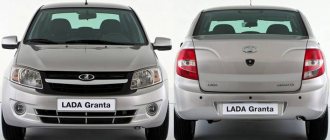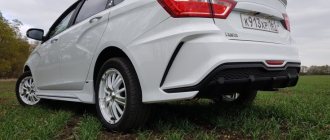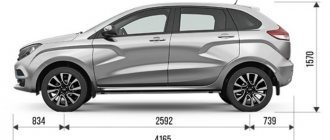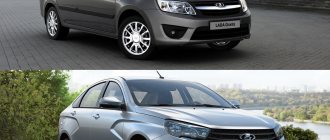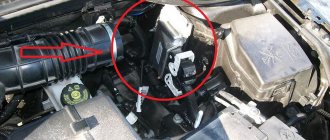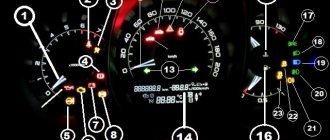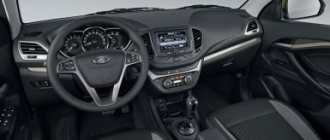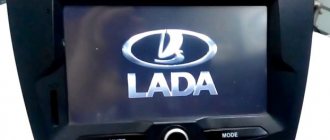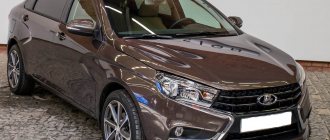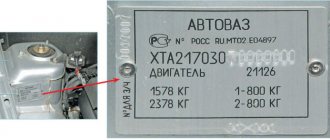Did not like:
- “Soft” windshield. Within six months it became worn out.
- Transmission. “Not a robot, but a KP. The second and third gears howl, this is innate. There is a worse problem - this transmission comes from the 80s, it was once a 4-speed, and the gear ratios in it are not optimal. Overtaking on the highway is strictly in 3rd gear; in 4th the car simply does not accelerate. Fortunately, there is a manual mode, and it is very convenient to overtake. But now I understand where there are a lot of tuning “series” for this gearbox.”
- Cheapness of used spare parts. “ All the rubber bands squeak. Racks work well for the first 50,000 km, then you can see a decrease in energy intensity. The same can be said about the stabilizer links.”
The owner considers the wear and tear of interior elements to be uncritical: the handles and buttons are like new, the seat is greasy, but there is no criminal pressure. “The most damaged thing is the steering wheel, it’s all scratched, although I don’t wear rings on my hands. There is one more “broken place” - the driver’s door trim. The new car had such a tight seat belt spring that it would literally fly out if you didn’t hold it with your hands.”
In general, the owner with the nickname serg1111 recommends the car for purchase, preferably a mechanic, since the robot is no longer made. “I would also take a variator - nothing will happen to it during the warranty period, but then how will it go.”
Read the full report here.
How the new Lada Vesta is protected from corrosion
The car body is made of galvanized steel. A cataphoresis primer is applied under the paint layer. The coating is resistant to mechanical stress. The cavities and recesses are treated with an oil-wax composition to prevent corrosion. The bottom and chassis elements are coated with a product that is resistant to humidity and temperature changes.
Checking Vesta for corrosion. Photo source: pikabu.ru
But Lada Vesta has problem areas that require corrosion treatment:
- Too thin a layer of mastic on the bottom, uneven application.
- The gaps at the joints of the body parts were treated with Movil with smudges, unevenly.
- Poor treatment with the compound in the area where the air conditioner breather exits.
- There is no anti-corrosion treatment at the junction of the trunk and rear side member.
- The rear arches do not have lockers, moisture and dirt accumulate on the metal surface.
- The plastic does not fit tightly to the front fender, allowing water to enter the cavity.
- There is no anticorrosive in the upper part of the hood, as well as on the lock.
- The door seal closes the drainage holes, moisture accumulates on the thresholds.
- A very thin layer of protective mastic in the trunk cavities.
The car's protection is no worse than that of its competitors. But it is advisable to additionally treat critical surfaces of the Lada Vesta with an anti-corrosion compound.
New era
The arrival of the French from Renault marked the beginning of a new century at VAZ. A lot of things have been and will be done, but the main thing that buyers have seen now are two new models - Vesta and X-RAY on “mother” platforms. The cars look very stylish, bright and modern - better than many competitors.
The designers did a great job. Of course, the interest of potential clients was and is very high. Photo: lada-vesta2.ru
One of the many questions that many people ask concerns the protection of metal from rust. Say, if Ladas are now quite comparable in price to budget foreign cars assembled in Russia, then perhaps the quality of bodywork right at the factory has increased? Maybe now you don’t need to carry out additional processing every few years, spending time and money on it? Much the same as what happens with a co-platform Renault Logan or any similar car. And if something happens, there is a guarantee against through corrosion.
The main places where rust appears on Vesta
Owners of Lada Vesta usually pay attention to the external manifestation of corrosion. But there are many hidden cavities and passages in the car where rust can appear. Standard processing does not last forever and requires periodic updating. The underside of the vehicle is subject to wear and tear due to ingress of solid particles. Additionally, reagents together with moisture can accelerate corrosion.
Corrosion on Vesta. Photo source: olade.ru
Surfaces where Lada Vesta rots:
- hidden body niches;
- uneven welds;
- ceiling steel panels;
- drainage holes;
- gaps under plastic linings;
- areas of body paint damage.
The state of protection of external parts can be assessed visually. A borescope is used to check the general condition of the cavity lining. To inspect the anti-corrosion coating, an ultrasonic thickness gauge is used, or, less commonly, a spark flaw detector.
Electroplating
What is the essence of this method? The operation involves the use of zinc ions, which are deposited on the body with negative polarity. The method uses the energy of direct electric current. Zinc ions are positively charged, and the body is negatively charged. In this way, the protective particles evenly coat the metal, protecting it from future corrosion. What cars use the electroplating method? These are German Mercedes, BMW, Japanese Honda, Toyota, and Mitsubishi. The Koreans from the Hyundai concern also practice electroplating. But Kia uses zinc metal technology. This coating consists of two layers. Used mainly on Optima and Serato.
Why does Lada Vesta rust?
New Lada Vesta cars have good anti-corrosion protection from the factory. But car owners sometimes notice signs of rust. Signs of corrosion are found even in a new car - on the suspension, in the gas removal system. Rust on Vesta appears on uneven weld seams in which dirt accumulates.
This is how the Lada begins to rust. Photo source: youtube.com
The main cause of corrosion is the accumulation of dirt and water in hidden body cavities. These parts are not well treated with protective mastic. Under the influence of reagents, rust occurs very quickly, capturing adjacent areas of the surface. Uneven application of the protective coating also leads to the appearance of pockets of corrosion.
Examination
A crossover was selected for inspection for test drives, 1 year old and with a mileage of 6400 km. He was driven onto an overpass, after which a check began. First, it was necessary to determine how well the car was processed from the factory in order to understand what actions to take.
Bottom
When examining the bottom, you can see that from the factory it has been perfectly treated with anti-gravel on the outside, and the welds have also been sealed. Judging by the applied composition, it is noticeable that this was done at the factory, and not at the dealership. In particular, you can find small areas where there is only a primer and no anti-gravel composition. But they are very small, and therefore do not pose a great danger. As a result, after a year of operation there are no noticeable areas covered with rust on the bottom.
Next, one of the plugs was removed from the spar to check how well the plant preserves the elements from the inside. After all, it is inside that corrosion begins to spread first - the formation of condensation, etc. Because of this, welds suffer.
However, in the case of anti-corrosion treatment of the Lada X-Ray, no such troubles were identified. After checking, it turned out that all the cavities were properly filled with a wax-based preservative.
Next, the threshold drainage holes were inspected. They turned out to be not only qualitatively processed (there are traces of excessive leakage of the composition, therefore, the internal cavity of the threshold is covered with anticorrosive), but also completely free, which means that condensate removal is as efficient as possible.
Small pockets of corrosion were recorded on the threads of the bottom studs, since they were not protected by anything. At first, this point will not have any effect, but over time, this problem will progress and later unscrewing the nuts will become problematic, and therefore it is recommended to check the threaded connections and treat them with lubricant.
Rust on threads
All tubes are protected by a special plastic casing, which is made in the form of a grid on the road surface side, which guarantees high-quality removal of moisture, dust and dirt. Naturally, off-road this element will not protect the hoses from a strong impact, however, from the point of view of anti-corrosion treatment of the Lada X-Ray, this decision is certainly correct.
The central tunnel is completely covered with panels made of heat-resistant and sound-absorbing material.
As in the case of the central part of the bottom, the rear spar is reliably protected from the inside - after removing the plug, there is abundant leakage of the wax-based compound.
All checks inside the side members were carried out both visually and using a special probe. It is also important that the preservative does not just lie in spots or concentrate directly at the technological hole, but is evenly distributed over the entire internal plane of the spar.
The only weak point is the central part of the spar, where there is noticeably less inside the composition, and therefore it is recommended to independently carry out anti-corrosion treatment on the Lada X-Ray in this direction and eliminate minor defects.
Doors
At the bottom of the front doors there are sufficiently large drainage holes that provide effective moisture removal. Preservative stains are also visible in them. The downside is that there are only 2 holes - at the edges. There is no central hole.
As a rule, AvtoVAZ does not treat the side end of the door from the inside with anticorrosive, and therefore it is recommended to treat this area yourself.
The side end of the front door, which is often not processed
The tailgate features only one drain hole, but it is located at a low point for improved efficiency. There is also a preservative.
The fifth door has several drainage holes, and after checking with an endoscope, it is noticeable that the inside surface of the metal is coated with anti-corrosion.
As you can see, there are no questions about the doors for anti-corrosion treatment of the Lada X-Rey.
Wheel arches
The rear arches are completely covered with lockers with noise-absorbing characteristics (there is a fleecy outer layer).
Is rust on Vesta covered under warranty?
The Lada Vesta manufacturer assumes certain obligations in the event of corrosion defects being detected. The car owner needs to have completed Lada Vesta coating inspection coupons in the service book. These marks must be entered after the sale in the showroom and then annually throughout the warranty period. The absence of the required document leads to refusal of repair work when corrosion occurs.
The plant provides a 6-year warranty on galvanized surfaces. Car dealers may provide additional benefits to buyers. When the first signs of corrosion appear, the owner of the Lada Vesta needs to contact a service center to repair the damage.
Vesta paintwork thickness
- On average 100-150 Microns throughout the bodywork;
- The thickness of the roof paintwork is 102 - 128 Microns;
- Doors 139 Micron;
- Front wing 140;
- Rear wing 144;
- Hood 104;
- Trunk lid 125.
Conclusion. Drawing conclusions let's say:
— Vesta has durable and well-protected body elements. In production, they use the cold galvanizing method, which is not the most reliable, but is used by European and Asian brands. Lada Vesta has a good layer of enamel, compared to cars produced by the AvtoVAZ plant previously. The presence of a good warranty period confirms the well-done work of the manufacturer.
How to protect Lada Vesta from rust
Anti-corrosion treatment extends the service life of the vehicle. This work is carried out as the protective mastic wears out. Corrosion manifests itself faster due to unfavorable climatic conditions and low-quality cheap protection materials. A rusty Lada Vesta can be restored using special protective compounds.
Additional factory anti-corrosion treatment
AvtoVAZ, in the interests of customers, applies additional corrosion protection. Factory processing locations:
- cavity near the scutes;
- the space between the shock absorber mount and the wheel arch;
- hidden space near the side members;
- cavity behind the sidewall trim;
- junction of the sill trim;
- cavity in the floor under the rear seat;
- luggage lid panels;
- cavities in door openings;
- hood panels.
In addition to the indicated places, the factory additionally processes body fasteners, holes and surface joints.
Processing in a car service
Good quality anti-corrosion protection can be provided by specialists involved in maintenance of Lada Vesta Cross, SW and sedan. Before treatment, the exterior and hidden cavities of the vehicle are thoroughly washed to remove dirt. Dry the car until moisture is completely removed from the surface.
Fret processing. Photo source: 37autoservis.ru
Procedure for applying anti-corrosion protection:
- Installing the car on a lift.
- Dismantling of plastic linings and protective aprons, seals.
- Dismantling the trunk trim, cleaning the cavity with a vacuum cleaner from debris and dirt.
- Cleaning rotten areas of the body. Treatment with primary anti-corrosion primer.
- Placing the car in a special chamber for spraying anticorrosive. Removing wheels. Installing covers on drive mechanisms, hoses and electrical wiring harnesses.
- Spraying an anti-corrosion agent onto the surface. Treatment of hidden cavities with a spray gun according to the manual scheme.
- Cleaning fresh compound from paintwork and plastic parts. Assembly of wheels, protective linings and seals.
- Dry the composition for 3-5 hours at room temperature.
When the protection dries, the car must not be moved. The thickness of the layer of applied composition is checked with a thickness gauge.
Do-it-yourself Vesta protection from corrosion
The car usually does not need additional rust treatment for the first 3 years. But it is better to check the condition of the coating annually. Protective compounds for metal surfaces:
- Underbody materials with gravel protection function. The composition must contain inhibitors and have noise-absorbing properties. Bitumen mastic with filler is suitable for this.
- The anti-corrosion composition of the wheel arch coating must be resistant to abrasive wear of the surface. A “liquid locker” or applying bitumen mastic in 2-3 layers is suitable for processing.
- Treatment of hidden cavities is carried out with liquid anticorrosive agent. The composition effectively displaces moisture and forms a dense film on the metal.
The use of high-quality compounds will protect the car from rust for 2-3 years.
As it was before
For many years, Zhigulis were primed using long-outdated technology, by anaphoresis treatment or anodic deposition. Moreover, even at the time Fiat built the plant in Togliatti, it was not the most modern, but the Italians did not sell their latest developments. And until 1978, they used imported components, until the USSR learned to make the necessary chemical compositions on their own.
Over time, the plant made a big breakthrough in this area. New equipment was purchased; instead of ordinary metal (only with primer), they began to use galvanized metal. In particular, as stated, on the “ten” (VAZ-2110) the number of such body elements is 30-50%, depending on the year of manufacture. For Priora and Kalina, this percentage reaches 70.
Since 1988, VAZ began to paint bodies, including metallic ones. Previously, this option was not available.
One way or another, the opinion has become firmly established among car enthusiasts that VAZs definitely need to be additionally “anti-bark,” that is, the body must be treated in addition to the factory one. Otherwise, even with careful use, the car will become covered with unpleasant red spots, and then completely rot very quickly. This especially applies to Moscow, where in winter a huge amount of chemical reagents are poured onto the streets, which, in addition to their direct task (fighting asphalt icing), literally corrode automobile metal.
What can you do to prevent measles?
Some people order the necessary operation at a service station (official, universal, or even a garage), other owners of Lada cars do not trust the craftsmen and prefer to do everything themselves, thus saving money on paying for the work - after all, you only need to purchase materials.
You can learn about the new concept presented the day before – the Pininfarina K350 – in our material.
You will find an overview of the characteristics and features of the Singulato iS6 Electric SUV here.
The most common compositions:
- various types of Movils. There are a huge number of manufacturers, even the verb “zamovilit” (process with Movil) has appeared;
- Body mastics. The number indicates the differences in the specific composition;
- cannon lard (an inexpensive and extremely popular petroleum-based lubricant that has water-repellent and preservative properties).
As for frequency, this is up to the owner of the car. Some people are not lazy to go over the body once a year, others process it every two or three years, or even less often.
You will find the test results of various anticorrosives in this video:
Choice of anticorrosive: compositions and prices
There are a lot of rust protection methods - from simple products to expensive imported mastics:
- Anticorrosive on Vesta is prepared with your own hands from “Gun Lard” and “Cordon” mastic. The total cost of the mixture is about 400 rubles per 1 kg. The product is applied to the surface with a brush.
- The product “Reduced lead ship” covers the surface with an oxide film. Price – 400 rubles per jar.
- Universal “Glue 88” is applied to a degreased surface. The water-repellent film reliably protects metal parts. The cost of glue is up to 400 rubles per package.
- Dinitrol sealant contains inhibitors and anti-gravel additives. Mastic has noise insulating properties. Packaging price – 1150 rubles.
- Anticorrosive Hi Gear contains rubber filler and additives that neutralize road reagents. Cost up to 400 rubles.
- The protective coating "Noksidol" is universal, also suitable for treating hidden cavities. The price of the package is about 700 rubles.
- LIQUI MOLY anti-corrosion agent is used even for old cars. Double application of mastic reliably protects against rust. The cost of the can is less than 500 rubles.
- Liquid Supra Shield easily penetrates into hidden cavities, displaces water and forms a durable protective film. The price of anticorrosive agent is low - 200 rubles per liter.
When choosing protection, it is necessary, in addition to the cost of the product, to take into account the condition of the surface.
How long will it last?
Along with the question of whether the body of the Lada Vesta is galvanized or not, many are interested in the validity period of this protection. The manufacturer itself provides a six-year warranty. Before launching into mass production, such a body was tested in a salt fog box. The body was in this room for about two and a half months. As the result showed, the body of the Lada Vesta coped well with the test. But how long will the metal last after the warranty period? Experts present their calculations. If one hundred microns of zinc is enough for 80-100 years, then a factory layer of 8-10 microns will last about seven to ten years. What to do after this period has expired? It is necessary to regularly monitor the condition of the paintwork and take preventive measures. We will talk about them further.
How to maintain the integrity of the Vesta body for a long time?
Knowing whether the body of the Lada Vesta is galvanized or not, you should not neglect preventive measures. First of all, this concerns washing. It should be regular, especially in winter. Many will say, why spend money and wash off dirt if it will protect the paint in an even layer from the same deposit. This belief is completely wrong. The fact is that in winter this dirt contains reagents that are sprinkled on the road by public utilities. And the larger the layer, the higher the risk of corrosion. This is especially true for areas that are treated only with a primer, without zinc. When washing, we pay special attention to arches and other hidden cavities (sills, bottom of wings). These places begin to rot first. Periodically check the drainage holes (at the bottom of thresholds and doors). They shouldn't be clogged. Otherwise, this will significantly accelerate the corrosion processes.
